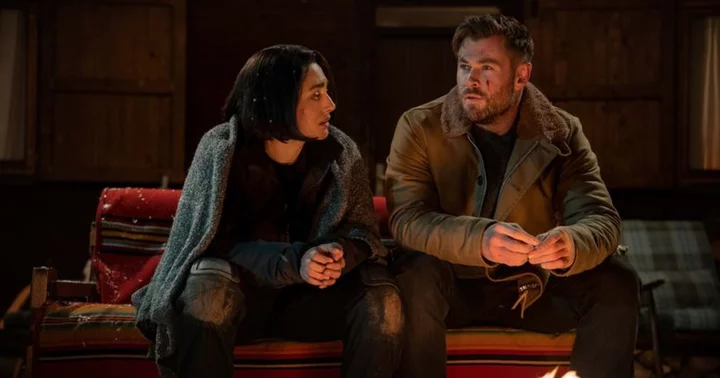Spoilers for ‘Asteroid City’
NEW YORK CITY, NEW YORK: The latest Wes Anderson’s classic masterpiece ‘Asteroid City’ has finally embraced its audience with vibrant visuals and immersive narratives. Anderson is not just a filmmaker, but an artist who shows depths of his underlying admiration though his work. If you’ve ever admired Anderson’s storytelling. ‘Asteroid City’ is his latest gem which you should definitely get tickets for. The movie goes above and beyond to anything that you have seen before, especially considering the A-list cast, however, falls into seams by the end.
The latest sci-fi comedy film, ‘Asteroid City’ is set in 1955 and chronicles a bunch of students and parents heading to a fictional desert town for an annual Junior Stargazer convention which is interrupted by unspecified events that would result in transformative change of people’s live, particularly those attending the convention. Wes Anderson’s new addition bespoke about the story of grief, science, and longing. The ingredients put together by Anderson guarantees to captivate this generation’s students. However, for those who find Anderson’s work too charmed might find themselves bored and unapologetically sorry for putting their time and energy with this movie. ‘Asteroid City’ is a small town which serve a deeply poignant purpose during the time of personal loss.
It wouldn’t do justice to Anderson’s ultimate work of art if we were to say it isn’t entertaining. In fact, it’s quite the opposite as it is wonders for some eyes and at the same time, unsatisfied and bewildering for others. Overall, the movie ensembles a lot of detail which is ravishing to the eye as every frame looks like an illustration come to life. The stunning gorgeous worlds put together by Anderson is something to marvel at, yet narratively, ‘Asteroid City’ failed to fully come together and is too easily forgettable.
'Asteroid City': Remarkable beauty yet devoid of life
‘Asteroid City’, a dessert town has a population of 87, a luncheonette, and is depicted as a dusty town. Wes Anderson's portrayal of ‘Asteroid City’ in his film is characterized by dense, intricately designed tableaux that offer glimpses into the lives of peculiar individuals residing in unconventional locations. The city itself serves as a physical centerpiece, similar to an experimental theater production aiming to convey a message, though that message remains somewhat elusive. The film explores the notion of nostalgia for the 1950s with the city becoming a blend of a desolate desert town and a stage set where protagonist Augie encounters other deadpan-speaking characters like Midge Campbell and June Douglas. Asteroid City's aesthetics exude a stylized charm reminiscent of a stage play, owing to Anderson's signature use of symmetrical framing and vibrant, yet soft, color palettes. However, the illusion begins to dissipate as the characters interact and reveal a lack of genuinely compelling dialogue. The film seems more invested in keeping the characters constantly talking rather than ensuring their conversations are engaging.
Anderson's fondness for meticulous visual composition and the grandeur of an extensive ensemble cast is evident in ‘Asteroid City’. The film's ambition is apparent in its sprawling cast and the polished appearance it presents to viewers. Overall, Anderson's portrayal of 'Asteroid City' combines his artistic flair for visual design, penchant for symmetrical framing, and vibrant color schemes. While the city's aesthetics and the film's grand scale are impressive, the dialogue and substance of the characters' interactions may leave something to be desired.
Who is Jason Schwartzman?
Augie Steenbeck (Jason Schwartzman), a war photographer, is dealing with the immense grief of losing his wife. He decides to keep her death a secret from their four children. It's not too difficult for Augie to hide the truth from his young triplet daughters as they view their family road trip as an exciting adventure. However, Augie struggles to conceal his inner turmoil from his teenage son, Woodrow, who shares his awkwardness and has a deep passion for astronomy. Their shared interest leads them to 'Asteroid City' where they attend a Junior Stargazer convention. Augie's story serves as the emotional core of the film. He grapples with being a widower and questions his ability to stand up to his father-in-law, Stanley, as well as raise his children without their mother by his side. 'Asteroid City' itself becomes a symbolic backdrop, featuring a desert landscape in gentle pastel tones, against which the movie's eccentric and deadpan characters are showcased like delicate dolls.
However, Augie's story is just one layer within the complex narrative structure of the film. ‘Asteroid City’ is not only a movie but also incorporates elements of a television show about a play with at least one production titled ‘Asteroid City’. This nested narrative structure explores the intertwined nature of storytelling and presents Augie as both a character within the movie and a participant in the broader narrative. Overall, the film explores Augie's personal journey of loss and self-discovery, set against the backdrop of 'Asteroid City'. It delves into themes of family, grief, and the interconnectedness of storytelling itself.
Story within the story
‘Asteroid City’ features a movie within a movie within a movie. Well, it is absurdly confusing, but it’s easier to watch than it sounds. The movie is a scripted film that presents itself as a TV show where actors simulate the production of a play that tells a fictional story about a nonexistent place. The play within the movie is also shown, but it is filmed like a traditional movie. The film's main plot revolves around a group gathered in 'Asteroid City' for a meteorite celebration, disrupted by an unexpected visitor. However, the movie initially presents itself as an old-school black-and-white anthology TV show hosted by Bryan Cranston, introducing the backstory of a play called ‘Asteroid City’ set in a fictional place. The film seamlessly switches between the colorful hyperreal version of the play, shot like a movie, and black-and-white scenes that depict moments during the production of ‘Asteroid City’.
Wes Anderson explores the concept of authenticity versus artifice by layering various levels of storytelling. Characters like Scarlett Johansson portray actresses playing actresses within the play, while Jason Schwartzman's character grapples with understanding his role as a war photographer who accidentally burns his hand. The film also delves into an acting class where students strive to deliver genuine performances despite the contrived nature of theater. Anderson's intent is to examine the elusive nature of authentic emotion within the context of artistic creation. The film explores the challenges of conveying true emotions through art forms that inherently involve fabrication and highlights the struggles and aspirations of actors trying to find genuine connections with their characters and audience.
In 'Asteroid City,' Wes Anderson constructs multiple interconnected realms where performance, artifice, and technology shape the experiences of its inhabitants. Despite these layers of artifice, genuine human emotions such as grief, longing, love, pain, and wonder permeate the lives of the characters. As the barriers they've created to shield themselves from their emotions begin to crumble, their worlds are shaken, leading them to ponder existential questions about life's meaning, the existence of God, and their sense of loneliness. By delving into the fictional and imaginative landscapes, the characters find a path towards self-discovery and connection to a greater understanding of their place in the world.
Ultimately, Anderson's portrayal of ‘Asteroid City’ invites viewers to explore the transformative power of art and the significance of embracing one's emotions and imagination to navigate the complexities of life and uncover profound truths.
'Asteroid City' is available on June 16 in the US and on June 23 worldwide near your theaters.









